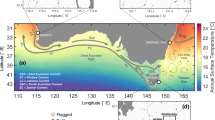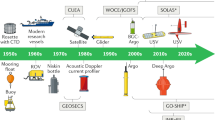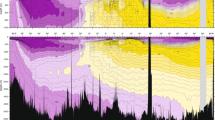Abstract
More than 90% of the heat energy accumulation in the climate system between 1971 and the present has been in the ocean. Thus, the ocean plays a crucial role in determining the climate of the planet. Observing the oceans is problematic even under the most favourable of conditions. Historically, shipboard ocean sampling has left vast expanses, particularly in the Southern Ocean, unobserved for long periods of time. Within the past 15 years, with the advent of the global Argo array of profiling floats, it has become possible to sample the upper 2,000 m of the ocean globally and uniformly in space and time. The primary goal of Argo is to create a systematic global network of profiling floats that can be integrated with other elements of the Global Ocean Observing System. The network provides freely available temperature and salinity data from the upper 2,000 m of the ocean with global coverage. The data are available within 24 hours of collection for use in a broad range of applications that focus on examining climate-relevant variability on seasonal to decadal timescales, multidecadal climate change, improved initialization of coupled ocean–atmosphere climate models and constraining ocean analysis and forecasting systems.
This is a preview of subscription content, access via your institution
Access options
Subscribe to this journal
Receive 12 print issues and online access
$209.00 per year
only $17.42 per issue
Buy this article
- Purchase on Springer Link
- Instant access to full article PDF
Prices may be subject to local taxes which are calculated during checkout





Similar content being viewed by others
References
Argo Science Team On the Design and Implementation of Argo – An Initial Plan for a Global Array of Profiling Floats ICPO Report No.21 (GODAE International Project office, Bureau of Meteorology, 1998).
Intergovernmental Oceanographic Commission Toward a Global Ocean Observing System: the Approach to GOOS IOC-XVII/8 (UNESCO, 1993).
Climate Change 2014: Synthesis Report (eds Core Writing Team, Pachauri, R. K. & Meyer, L.) 151 (IPCC, 2014).
Climate Change 2007: Synthesis Report (eds Core Writing Team, Pachauri, R. K. & Reisinger, A.) (IPCC, 2007).
Wong, A. & Riser, S. Profiling float observations of the upper ocean under sea ice off the Wilkes Land coast of Antarctica. J. Phys. Oceanogr. 41, 1102–1115 (2011).
Wong, A. & Riser, S. Modified shelf water on the continental slope north of Mac Robertson Land, East Antarctica. Geophys. Res. Lett. 40, 6186–6190 (2013).
Wong, A., Johnson G. & Owens, W. B. Delayed-mode calibration of autonomous CTD profiling float salinity data by theta-S climatology. J. Atmos. Ocean. Technol. 20, 308–318 (2003).
Owens, W. B. & Wong, A. An improved calibration method for the drift of the conductivity sensor on autonomous CTD profiling floats by theta-S climatology, Deep-Sea Res. Pt I 56, 450–457 (2009).
Gaillard, F. et al. Quality Control of Large Argo Datasets. J. Atmos. Ocean. Technol. 26, 337–351 (2009).
Levitus, S. Climatological Atlas of the World Ocean NOAA Professional Paper 13 (US Government Printing Office, 1982).
von Schuckmann, K., Gaillard, F. & Le Traon, P.-Y. Global hydrographic variability patterns during 2003–2008. J. Geophys. Res. 114, C09007 (2009).
Ollitrault, M. & Rannou, J.-P. ANDRO: An Argo-based deep displacement dataset. J. Atmos. Ocean. Technol. 30, 759–788 (2013).
Ollitrault, M. & De Verdiere, C. The ocean general circulation near 1000 m depth. J. Phys. Oceanogr. 44, 384–409 (2014).
Gray, A. & Riser, S. A global analysis of Sverdrup balance using absolute geostrophic velocities from Argo. J. Phys. Oceanogr. 44, 1213–1229 (2014).
Castelao, R. Mesoscale eddies in the South Atlantic Bight and the Gulf Stream recirculation region: vertical structure. J. Geophys. Res. 119, 2048–2065 (2014).
Zhang, Z., Wang, W. & Qiu, B. Oceanic mass transport by mesoscale eddies. Science 345, 322–324 (2014).
Hennon, T., Riser, S. & Alford, M. Observations of internal gravity waves from Argo floats. J. Phys. Oceanogr. 44, 2370–2386 (2014).
Mercier, H. et al. Variability of the meridional overturning circulation at the Greenland--Portugal OVIDE section from 1993 to 2010. Progr. Oceanogr. 132, 250–261 (2015).
Guinehut, S., Dhomps A., Larnicol, G. & Le Traon, P.-Y. High resolution 3-D temperature and salinity fields derived from in situ and satellite observations. Ocean Sci. 68, 845–857 (2012).
Willis, J. K. & Fu, L.-L. Combining altimeter and subsurface float data to estimate the timeaveraged circulation in the upper ocean. J. Geophys. Res. 113, C12017 (2008).
Willis, J. K. Can in situ floats and satellite altimeters detect long-term changes in Atlantic Ocean overturning? Geophys. Res. Lett. 37, L06602 (2010).
Chang, Y., Zhang, S., Rosati, A., Delworth, T. & Stern, W. An assessment of oceanic variability for 1960–2010 from the GFDL ensemble coupled data assimilation. Clim. Dynam. 40, 775–803 (2013).
Roemmich, D, Gould, W. J. & Gilson, J. 135 years of global ocean warming between the Challenger expedition and the Argo Programme. Nature Clim. Change 2, 425–428 (2012).
Hobbs, W. & Willis, J. Detection of an observed 135 year ocean temperature change from limited data. Geophys. Res. Lett. 40, 2252–2258 (2013).
Levitus, S. et al. Anthropogenic warming of earth's climate system. Science 292, 267–270 (2001).
Roemmich, D & Gilson, J. The 2004–2008 mean and annual cycle of temperature, salinity, and steric height in the global ocean from the Argo Program. Progr. Oceanogr. 82, 81–100 (2009).
Roemmich, D. et al. Unabated planetary warming and its anatomy since 2006. Nature Clim. Change 5, 240–245 (2015).
Durack, P. & Wijffels, S. Fifty-year trends in global ocean salinities and their relationship to broad-scale warming. J. Clim. 23, 4342–4362 (2010).
Hosoda, S., Suga, T., Shikama, N. & Mizuno, K. Global surface layer salinity change detected by Argo and its implication for hydrological cycle intensification. J. Oceanogr. 65, 579–586 (2009).
Durack, P., Wijffels, S. & Matear, R. Ocean salinities reveal strong global water cycle intensification during 1950–2000 Science 336, 455–458 (2012).
Manabe, S. & Stouffer, R. Multiple-century response of a coupled ocean-atmosphere model to an increase of atmospheric carbon dioxide. J. Clim. 7, 5–23 (1994).
Yashayaev, I. & and Loder, J. Enhanced production of Labrador Sea Water in 2008. Geophys. Res. Lett. 36, L01606 (2009).
Kieke, D., Yashayaev, I. Studies of Labrador Sea Water formation and variability in the subpolar North Atlantic in the light of international partnership and collaboration. Prog. Oceanogr. 132, 220–232 (2015).
Ren, L. & Riser, S. Seasonal salt budget in the northeast Pacific Ocean. J. Geophys. Res. 114, C12004 (2009).
Ren, L. & Riser, S. Observations of decadal-scale salinity changes in the thermocline of the North Pacific Ocean. Deep Sea Res. Pt II 57, 1161–1170 (2010).
Freeland, H. Evidence of change in the winter mixed layer in the Northeast Pacific Ocean: a problem revisited. Atmos. Ocean, 51, 126–133 (2013).
Hansen, J., Lacis, A. & Rind, D. in Proc. Third Symp. Coast. Ocean Manage. (eds Magoon, O. T & Converse, H.) 2796–2810 (ASCE, 1984).
Palmer, M., McNeall, D. & Dunstone, N. Importance of the deep ocean for estimating decadal changes in Earth's radiation balance. Geophys. Res. Lett. 38, L13707 (2011).
Rhein, M. et al. in Climate Change 2013: The Physical Science Basis (eds Stocker, T. et al.) Ch. 3 (IPCC, Cambridge Univ. Press, 2013).
Sutton, P. & Roemmich, D. Decadal steric and sea surface height changes in the Southern Hemisphere. Geophys. Res. Lett. 38, L08604 (2011).
Kosaka, Y. & and Xie, S.-P. Recent global-warming hiatus tied to equatorial Pacific surface cooling. Nature 501, 403–407 (2013).
Levitus, S. et al. World ocean heat content and thermosteric sea level change (0–2,000 m), 1955–2010. Geophys. Res. Lett. 39, L10603 (2012).
Durack, P., Gleckler, P., Landerer, F. & Taylor, K. Quantifying underestimates of long-term upper ocean warming. Nature Clim. Change 4, 999–1005 (2014).
Freeland, H. et al. Argo-a decade of progress. In Proc. Ocean Obs'09 Vol. 2, WPP-306 10.5270/OceanObs09.cwp.32 (ESA, 2010).
Kwon, Y.-O. et al. Role of Gulf Stream, Kuroshio-Oyashio, and their extensions in large-scale atmosphere-ocean interaction: a review. J. Clim. 23, 3249–3281 (2010).
Saji, N., Goswami, B., Vinayachandran, P. & Yamagata, T. A dipole mode in the tropical Indian Ocean. Nature 401, 360–363 (1999).
Klatt, O., Boebel, O. & Fahrbach, E. A profiling float's sense of ice. J. Atmos. Technol. 24, 1301–1308 (2007).
Johnson, K. et al. Observing biogeochemical cycles at global scales with profiling floats and gliders: prospects for a global array. Oceanography 22, 216–225 (2009).
Brasseur, P. et al. Integrating biogeochemistry and ecology into ocean data assimilation systems. Oceanography 22, 206–215 (2009).
Bio-Optical Sensors on Argo Floats IOCCG Report No. 11 (eds Claustre, H.) (IOCCG, 2011).
Frolicher, T. et al. Dominance of the Southern Ocean in anthropogenic carbon and heat uptake in CMIP5 models. J. Clim. 28 862–886 (2015).
Morrison, A., Frolicher, T. & Sarmiento, J. Upwelling in the Southern Ocean. Phys. Today 68, 27–29 (2015).
Fukasawa, M. et al. Bottom water warming in the North Pacific Ocean. Nature 427, 825–827 (2004).
Johnson, G., Purkey, S. & Bullister, J. Warming and freshening in the abyssal southeastern Indian Ocean. J. Clim. 21, 5351–5363 (2008).
Purkey, S. & Johnson, G. Warming of global abyssal and deep Southern Ocean waters between the 1990s and 2000s: contributions to global heat and sea level rise budgets. J. Clim. 23, 6336–6353 (2010).
Purkey, S. & Johnson, G. Antarctic Bottom Water warming and freshening: contributions to sea level rise, ocean freshwater budgets, and global heat gain. J. Clim. 26, 6105–6122 (2013).
Argo Science Team Argo Float Data and Metadata from Global Data Assembly Centre (Argo GDAC) - Snapshot of Argo GDAC as of September, 8th 2015 (Ifremer, 2015); http://dx.doi.org/10.12770/ca035889-880d-463e-a523-10aabc3d6be3
Boyer, T. et al. World Ocean Database 2009 NOAA Atlas NESDIS (ed. Levitus, S.) 66 (US Government Printing Office, 2009).
Acknowledgements
Argo data were collected and made freely available by the International Argo Programme and the national programmes that contribute to it. The Argo Programme is part of the Global Ocean Observing System. Thanks to Igor Yashayaev for constructing Fig. 4 as his contribution to the Atlantic Zone Off-Shelf Monitoring Program (led by the Department of Fisheries and Oceans, Canada) and to the International Argo Programme.
Author information
Authors and Affiliations
Contributions
The paper was written by S.C.R. (60%) and H.J.F. (40%), with editorial comments and suggestions provided by the remaining co-authors who have all served as members of the Argo Steering Team and so have contributed significantly to the Argo programme.
Corresponding author
Ethics declarations
Competing interests
The authors declare no competing financial interests.
Rights and permissions
About this article
Cite this article
Riser, S., Freeland, H., Roemmich, D. et al. Fifteen years of ocean observations with the global Argo array. Nature Clim Change 6, 145–153 (2016). https://doi.org/10.1038/nclimate2872
Received:
Accepted:
Published:
Issue Date:
DOI: https://doi.org/10.1038/nclimate2872
This article is cited by
-
Global and regional ocean mass budget closure since 2003
Nature Communications (2024)
-
Warming and lateral shift of the Gulf Stream from in situ observations since 2001
Nature Climate Change (2023)
-
Widespread global disparities between modelled and observed mid-depth ocean currents
Nature Communications (2023)
-
Development of Autonomous Underwater Profiling Drifter (AUPD) and field results
Journal of Earth System Science (2023)
-
Twenty years of ocean observations with China Argo
Acta Oceanologica Sinica (2023)



